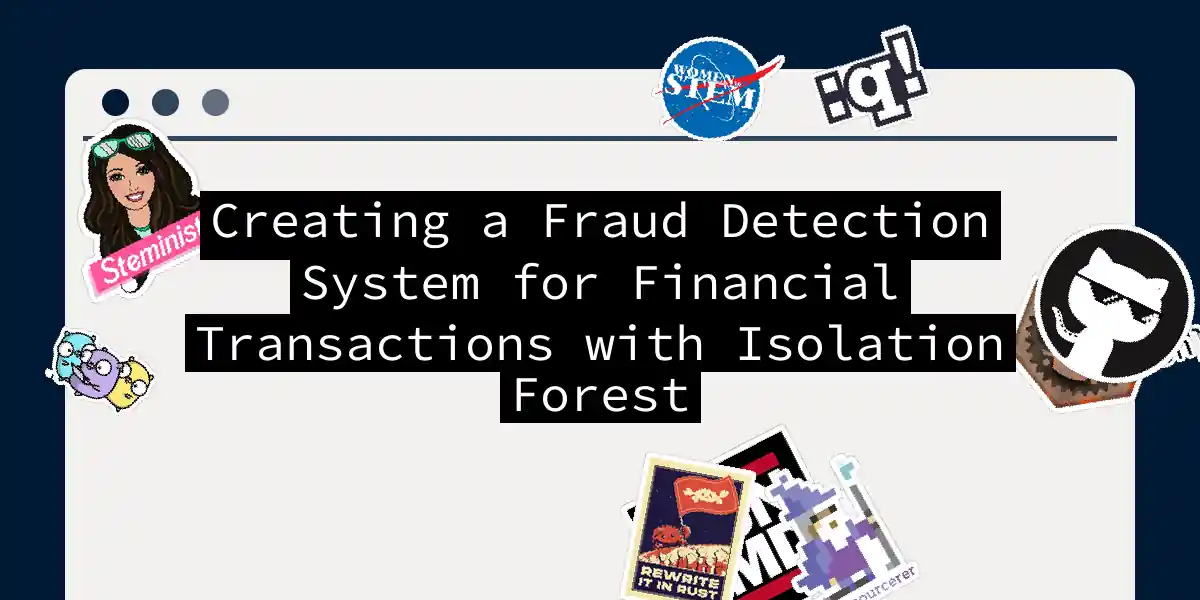Introduction to Fraud Detection
In the world of finance, fraud is a constant and evolving threat. Detecting fraudulent transactions is a critical task that requires parsing through vast amounts of data, often in real-time. Traditional methods can be cumbersome and inefficient, especially when dealing with large datasets. This is where the Isolation Forest algorithm steps in, offering a powerful and efficient solution for anomaly detection.
What is Isolation Forest?
Isolation Forest is an unsupervised machine learning algorithm designed to detect anomalies or outliers in datasets. Unlike traditional methods that profile normal data points and then identify outliers, Isolation Forest directly isolates anomalies by creating isolation trees through random partitioning of the feature space. This approach makes it highly efficient, with a linear time complexity, which is a significant improvement over algorithms like DBSCAN that have log-linear time complexity[1].
Here’s a simplified overview of how Isolation Forest works:
Why Use Isolation Forest for Fraud Detection?
Isolation Forest is particularly well-suited for fraud detection due to several reasons:
- Efficiency: It runs quickly and can handle large datasets, making it ideal for real-time applications.
- Unsupervised Learning: It does not require labeled data, which is often scarce in fraud detection scenarios.
- Anomaly Detection: It excels at identifying outliers, which are typically indicative of fraudulent activities[1][3].
However, it’s important to note that Isolation Forest is not without its limitations. It often requires parameter tuning and can be sensitive to sample size, where larger samples can lead to “swamping” and “masking” effects, reducing the model’s effectiveness[1].
Practical Use Case: Detecting Fraudulent Credit Card Transactions
To illustrate the application of Isolation Forest in fraud detection, let’s consider a practical use case involving credit card transactions.
Dataset
We will use the popular Credit Card Fraud Detection dataset from Kaggle, which contains 284,807 transactions made by European cardholders over a two-day period in September 2013. Only 492 of these transactions are fraudulent, representing a severe class imbalance[1].
Workflow
Here is a step-by-step guide to setting up an Isolation Forest model for fraud detection using the KNIME Analytics Platform, which provides out-of-the-box support for Isolation Forest through the ‘KNIME H2O Machine Learning Integration’ extension.
Training the Model
- Read Training Data: Load the dataset from the specified data source.
- Preprocess Data: Split the data into two sets:
- The top port contains ⅔ of the normal transactions.
- The bottom port contains the remaining normal transactions along with all the fraudulent transactions.
- Train the Isolation Forest Model: Use the top port data to train the model.
- Apply the Model: Apply the trained model to the bottom port data.
- Classify Transactions: Classify transactions based on the mean length of the isolation tree, where a shorter length indicates a higher likelihood of fraud.
- Evaluate Model Results: Check the overall accuracy of the model using the Scorer node.
- Save the Model: Save the model for deployment in subsequent workflows[1].
Deployment
- Read the Model and New Data: Load the saved model and new incoming transaction data.
- Apply the Isolation Forest: Use the model to classify the new transaction.
- Classify the New Transaction: Determine if the transaction is fraudulent based on the mean length from the ‘H2O Isolation Forest Predictor’.
- Send Email Notification: If the transaction is flagged as fraudulent, send an email notification to relevant parties[1].
Performance Evaluation
The performance of the Isolation Forest model can be evaluated using metrics such as accuracy, precision, and recall. In our example, the model achieved an overall accuracy of 97.49%, which is comparable to other well-performing techniques like Random Forest and DBSCAN[1].
Additional Considerations and Improvements
Parameter Tuning
Isolation Forest requires careful parameter tuning to optimize its performance. Parameters such as the number of trees in the forest and the maximum depth of the trees can significantly impact the model’s accuracy and efficiency[1].
Handling Class Imbalance
Given the severe class imbalance in fraud detection datasets, techniques such as oversampling the minority class or using class weights can help improve the model’s performance on detecting fraudulent transactions[1].
Combining with Other Methods
Isolation Forest can be combined with other anomaly detection methods, such as Local Outlier Factor (LOF) or clustering, to improve overall detection accuracy. For example, Isolation Forest has been shown to outperform LOF and SVM in certain scenarios, but combining these methods can provide a more robust detection system[2].
Conclusion
Isolation Forest is a powerful tool for detecting fraudulent transactions in financial datasets. Its efficiency, ability to handle large datasets, and unsupervised nature make it an ideal choice for real-time fraud detection systems. By following the steps outlined above and considering additional improvements such as parameter tuning and combining with other methods, you can create a robust and effective fraud detection system.
Remember, in the world of finance, staying one step ahead of fraudsters is a constant battle. With Isolation Forest, you have a formidable ally in this fight. So, go ahead and isolate those anomalies – your customers (and your bottom line) will thank you.
